 By Bob Currie, Recreational Boating Safety Specialist
By Bob Currie, Recreational Boating Safety Specialist
U.S. Coast Guard Auxiliary Station Galveston Flotilla
Boating has evolved into much more than just a way to get across a body of water. It is only natural that it did so since two thirds of the surface of the earth is covered by water. While operating a boat or riding in a boat is what most people think of in conjunction with recreational boating, there is another way to enjoy boating, and that is as a spectator. Although you can go down to the water’s edge and look for boats passing, there is no guarantee you will actually see a boat from your observation point. You can change that chance of seeing a boat on the water to 100% by attending an organized event such as a boat race or a boat parade. We call such events regattas.
The Station Galveston Flotilla of the US Coast Guard Auxiliary operates out of the USCG Station Galveston base on Galveston Island. They aid the Coast Guard by providing maritime observation patrols in Galveston Bay; by providing recreational boating vessel safety checks; and by working alongside Coast Guard members in maritime accident investigation, small boat training, providing a safety zone, Aids to Navigation verification, in the galley, on the Coast Guard Drone Team and watch standing.
There are several types of regattas. They include powerboat regattas, sailboat regattas, rowing regattas, and marine parades. The U.S. Coastguard has a long history of providing support to regattas by providing regatta patrols of either Coast Guard or Coast Guard Auxiliary patrol boats. Here is a brief discussion of the types of regattas that Coast Guard Sector Houston-Galveston supports.
Regatta Patrols
Regatta courses range in size from a small area in which an onshore spectator can see the entire race to large courses that cover areas that are miles in length. A regatta may only have a handful of boats participating, or it may consist of hundreds of boats such as the large sailboat regattas. When the course is large, a good pair of binoculars can increase the amount of the course visible to onshore spectators. For this weekend’s regatta I had access to a pair of binoculars that allowed me to see the facial expressions of the crews from a mile away. Often there are many spectators who are in boats, and it is the safety of the spectator boats that is the concern of the Coast Guard. The safety of the participant vessels is the responsibility of the sponsoring organization. A regatta sponsoring organization may make a written formal request to the Coast Guard to provide regatta patrols. The most common regatta in the Galveston-Houston area is the sailboat regatta. Sailboats on the sea are very pleasing to the eye and thus sailboat regattas are quite popular spectator sports. Although we have some large sailboat regattas that have 50-mile and larger courses, the catamaran sailboat regattas are the most popular due to the fact that with a good set of binoculars you can see the entire race from the shore. Powerboat regattas fall into the same category and are exciting to people who love to see fast-moving boats. If you decide to view a regatta from your boat, then an understanding of how regattas work will help you stay in a safe position to view the regatta.
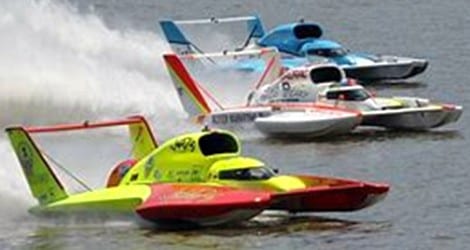 Image Source: Powerboat Racing World
Image Source: Powerboat Racing World
Powerboat Regattas
A powerboat regatta is generally held on a large rectangular or oval course. These courses are of various length, depending on the class of the powerboats and the area in which the race is being held. When support is provided by the Coast Guard, patrol sectors are established and patrol boats will remain within their assigned sectors. Dividing the patrol areas into sectors facilitates regulation of traffic and keeps obstructions and spectator vessels from the racecourse itself. There are two ways in which patrol vessels are used: either as marker vessels or screen vessels. Marker vessels are positioned to mark limits of restricted areas. Screen vessels maneuver in formation around the perimeter of the racecourse to be continually between the race participants and the spectators. Wakes from spectator vessels can be a hazard to race participants, so speeds close to the racecourse should be kept to a minimum. Patrol vessels carry signs that are used to help control spectators. One such sign reads “SLOW DOWN.” If you are in a spectator vessel and see this sign aimed in your direction, please reduce your speed and eliminate throwing a large wake. Another sign says “RESTRICTED AREA.” That means you are too close to the racecourse. You don’t want to maneuver in front of a boat moving at 100+ mph.
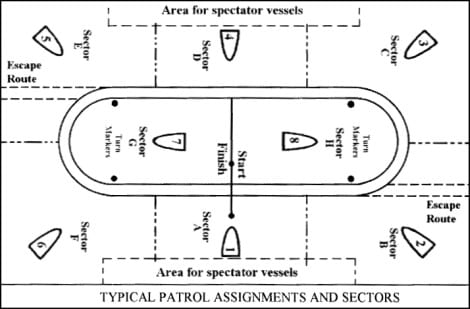
The safest way to observe a powerboat regatta from your boat is to obtain the coordinates of the racecourse in advance from the sponsoring organization, get to the spectator area early, and anchor your boat, taking care to ensure that any swingout along the anchor line does not put you too close to the racecourse or put you in danger of hitting another anchored spectator vessel. If you are observing a powerboat regatta from the shore, if you enter the water to cool off or observe the race be sure to not get close to the course. Some powerboat courses run quite close to the shore.
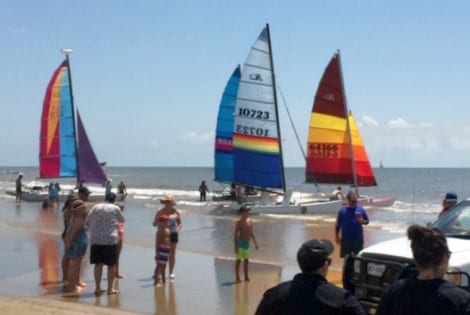 Bolivar Rig Run Regatta, August 15, 2020. Photo by Bob Currie
Bolivar Rig Run Regatta, August 15, 2020. Photo by Bob Currie
Sailboat Regattas
Although other courses may be used for sailboat regattas, a triangular course in which one side is sailed three times is the most common. The Bolivar Rig Run this weekend, although triangular in shape, involved sailing each leg only once. The race committee published the racecourse with coordinates for use by spectator boats, participants, and regular marine traffic such as local shrimp boats. As a member of the safety committee, I visited local shrimp docks and talked to the shrimpers. They assured me that the shrimp had moved offshore to deeper waters and no local boats would be operating in the area of the racecourse. Although we did have several spectator vessels, no commercial fishing boats came within miles of the course.
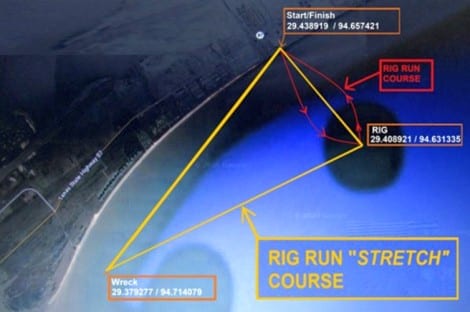
Sailboat regattas can be dangerous for the participants as there is always the danger of capsizing. In the race this weekend five catamarans capsized. Of those five, three of the crews were able to right their boats and continue on. One experienced crew had their boat righted within three minutes of capsizing. Two boats had to have assistance in righting. Both boats were crewed by one person only. While small catamarans are easy to right by a single person, larger sailboats require more than one person due to the distance between the hulls. Righting a boat consists of pointing the top of the mast into the wind, standing on the hull that is in the water, then grabbing hold of the hull that is sticking out of the water from the backside and leaning back. As soon as the mast breaks the surface of the water, the sail catches the wind and the boat quickly uprights itself. You just have to get that mast out of the water a little bit, and sometimes a single person just doesn’t have the leverage.
Spectator safety consists of staying out of the path of a sailboat, whether you are on shore or in a recreational vessel. Racing sailboats must take advantage of all wind conditions during the race and as a result are tacking back and forth along the coast. As one sailor told me, you can’t get there from here. In the race this weekend, the wind was predominantly out of the west, and the long course first leg was due west. In order to get far enough out in order to tack against the wind, the sailboats proceeded southeast at the start of the race, easily adding two miles to the course in the process of getting far enough out to begin tacking westward. Since the catamaran sailboat course starts from shore, it is easy for onshore spectators to put themselves in danger. A gust of wind could catch a sail and capsize the boat at any time, and a thirty-foot mast could easily injure someone in its path to the ground.
Spectators often are in the water too near the boats and it is a hard job for the safety team to keep them from getting too close to the boats either just before they launch or when they are returning to shore. The boats often hit the shore at speeds approaching 20 mph, and the sailors have little chance to dodge spectators in the water near the end of course markers. So, as an onshore spectator, you must be ever vigilant when sailboats are nearing the end of the course. Sailboats make no noise, so you cannot depend upon your hearing as a warning that a sailboat is getting close. Another thing to keep in mind is that although you might want to help the sailing team once their boat has returned to shore, they almost never want spectator help. It is too dangerous to approach a sailboat in shallow water. Waves can toss it about and the wind can topple it. It would be safer for you to enter a bull ring than to approach a sailboat, especially with heavy wave action.
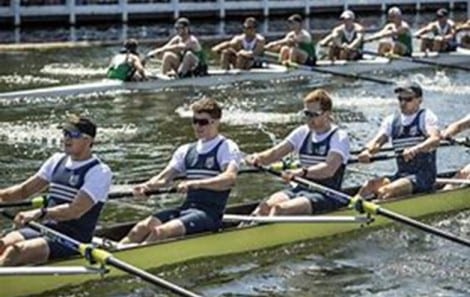 Royal Canadian Henley Regatta 2019. Image from Bing.
Royal Canadian Henley Regatta 2019. Image from Bing.
Rowing Regattas
Rowing regattas, also known as the sport of crew racing, are popular with colleges and prep schools. The vessels are very light one or two-place sculls, or four to eight-place shells. They are very easy to capsize, and it is very important to have a smooth course with no waves. The races are held on a straight course with marker vessels to either side with a screen vessel behind to prevent spectator vessels from interfering. Racing participants seldom wear life jackets. As an onshore spectator it is important not to encroach too closely to the racecourse. As a spectator in a boat it is important to find a position not too close to the course and to firmly anchor where swingout does not put you close to the course or to another spectator vessel. You should find a position well before the start of the race so that any wake you make getting into position has dissipated.
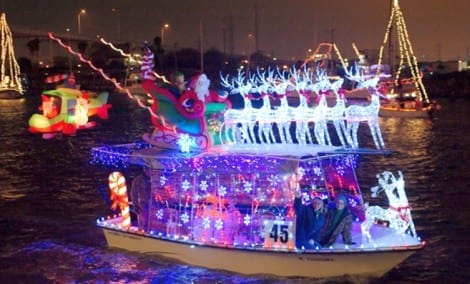 Kemah Christmas Parade 2019. Image texascoopower.com
Kemah Christmas Parade 2019. Image texascoopower.com
Marine Parades
The best Marine parade I have ever seen was when my youngest son graduated from boot camp. The best marine parade, however, is the Kemah Boardwalk Christmas Parade. I was on one of the Coast Guard Auxiliary patrol boats assigned to the 2019 Christmas Parade. Everyone lights up their boats and runs an oval pattern that puts them close enough to the boardwalk to throw trinkets to the spectators. Our hardest job was keeping non-participating boats from jumping into the parade line. It was okay for spectator boats to navigate to sea through the course limits since the course took up a whole section of the channel. A marine parade course may be either rigid or varying. Our patrol vessel took up a position at the starting point. The entire course was two miles long and oval shaped, and participants entered the course at varying times but always at the starting point. As with other types of regattas, if you are going to be in a spectator boat then you should obtain the course coordinates so that you don’t interfere with the regatta. If you are an onshore spectator, you need to yell, cheer, and make lots of noise if you expect to get trinkets.
Summary
Recreational boating isn’t just for boat owners. You can have just as much fun by observing a regatta from the shore, maybe more enjoyment as you are more likely to have access to a restroom as needed. There are some safety considerations for onshore spectators as well as for persons aboard spectator vessels. The key is to observe the sanctity of the course limits and to place yourself where you are not in danger from race participant boats or to race participant boats, and to anchor in a place that will not allow you to get too close to the course or other spectator vessels if your boat swings about its anchor line.
For more information on boating safety, please visit the Official Website of the U.S. Coast Guard’s Boating Safety Division at www.uscgboating.org. Questions about the US Coast Guard Auxiliary or our free Vessel Safety Check program may be directed to me at [email protected]. SAFE BOATING!
[Aug-17-2020]

 Posted in
Posted in 

























Great article and dead on as far as righting a capsized catamaran. The one thing I may add in sailing in Bolivar waters is that if one should capsize they should not expect any support in righting the boat back over. The average catamaran takes 300 pounds working together, a proper righting line, and the correct technique as you explained. Its best to have 2 people, a radio or cell phone because as we all found out the demasting that occured last year at the rig last year and the one near shore there is little anyone can do but take the boat to shore. If sailing solo, one should always tell someone else what your plans are for returning.